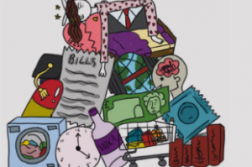Once defined by quarterly seasons, the fashion industry has been revolutionised by fast fashion over the past 30 years. Since 2000, the clothes we buy has doubled to over 2 million tons per year in the UK, largely due to retailers pushing weekly trends, making it impossible to keep up. These clothes have made fashion the world’s second most polluting industry. They are mass-produced using poor quality synthetic fabrics, shipped globally, and 57% end up in landfill within 12 months of purchase, taking up to 450 years to biodegrade.
In efforts to tackle this mounting problem sustainable fashion has become a trend. But with unattainable heights set by influencers promoting changing every aspect of your life, and environmental organisations arguing that the impact of fashion cannot be reduced until fast fashion companies are no longer the default, how can we actually embrace slow fashion and if we do, will this truly reduce the impact of the fashion industry on our planet?
- Organise your wardrobe
Familiarising yourself again with clothes you already own might stop you from buying more. You’ll also likely find evidence of the fast-moving trends that control our buying habits. Try to donate or sell the items you no longer want – you might even make a bit of money on something you would have otherwise thrown away.
- Invest in a mini sewing kit
Walk into any supermarket and you’ll find sewing kits in the Household Essentials aisle. With hundreds of beginner sewing tutorials online, making that blouse last an extra few years takes a matter of minutes. For bigger issues, commission a seamstress (many promote their services on Facebook) or even sell on eBay, simply specify any faults and someone will likely still buy your item to upcycle.
- Get creative
In 2020 TikTok proved you don’t need to be Vivienne Westwood to make your own clothes. So, remember that getting rid of an item you no longer love isn’t the only option. If you aren’t naturally creative, don’t let this intimidate you! There are loads of tutorials that can help you upcycle your clothes and this could be as simple as dyeing some blue jeans black.
- Only buy new when absolutely necessary
When shopping, ask, ‘if this wasn’t a trend, would I still like it?’ If yes, great, but also remember that trends are cyclical. Take a quick look in second-hand stores and you’ll likely find something similar for a fraction of the price. Many charity shops also sell online too – one good thing to come out of lockdown!
Please remember that buying new cannot and should not be avoided entirely. To reduce your impact though, look to sustainable brands or try the app ‘Good On You’ for help finding alternatives to your favourite shops.
- Sustainable slogans do not equal sustainability
Since sustainability has become a trend, doing your own research is possibly the most important thing to remember. Check labels for organic and recycled fibres. Look for statements of water reduction also, particularly on cotton, as this is proof that the item has been made with sustainable materials. I would also recommend further research on the industry as a whole. Some useful resources are the documentary ‘Slowing Down Fast Fashion’, TheCommonObjective.org, ‘The Pre-Loved Podcast with Emily Stochl’, and ‘Overdressed’, a book by a reformed shopaholic.
Sustainable fashion doesn’t need to be the intimidating movement it seems. Consumers drive demand, so while your small changes may not seem like much, by embracing slow fashion we can force change and make a real impact on the health of our planet.



